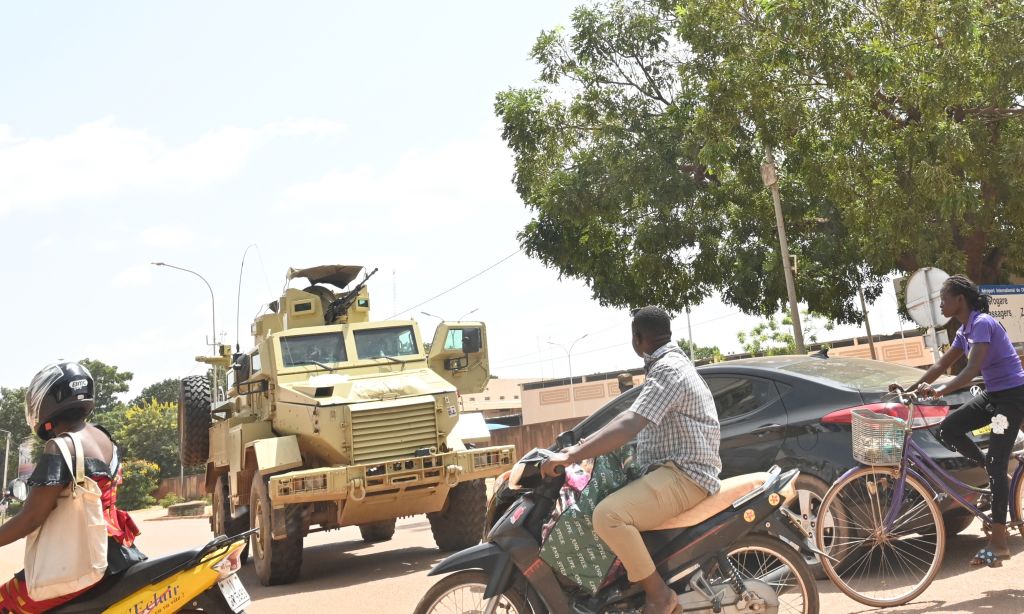ADF STAFF
The use of drones by Burkina Faso’s military is drawing criticism and calls for restraint amid reports of heavy civilian casualties. Burkinabe military drone strikes killed more than 60 civilians and injured scores more over a four-month stretch in late 2023, Human Rights Watch (HRW) reported. The military junta led by Capt. Ibrahim Traoré reported that the drone strikes targeted terrorists.
The civilians reportedly were killed during three attacks starting in early August, when members of the Jama’at Nusrat al-Islam wal-Muslimin (JNIM) violent extremist organization rode motorcycles into a market in the southwestern village of Bouro.
When the terrorists reached the market, it was hit by a drone strike that was described by Radiodiffusion Télévisiondu Burkina (RTB), Burkina Faso’s government-run television network, as a successful air operation “based on intelligence” that a group of terrorists were “preparing large-scale attacks.”
“The market was full of civilians when the drone hit,” a 25-year-old man told HRW. “People from all over the area come to the market to buy and sell animals.”
RTB in late September 2023 aired footage of a Burkinabè military drone attack on 18 motorbikes entering the village of Bidi, near the Malian border. RTB reported that rebel fighters were “successfully hit” by a drone strike as they “stopped in a village.” JNIM forces have besieged Bidi since 2021.
The RTB report contradicts the accounts of people interviewed by HRW, who said that about 100 people were attending a funeral when the drone strike hit and that no terrorists were present. Witnesses said that 24 men and a boy were killed, and 17 were injured, all civilians.
“The strike was just a terrible mistake,” a 45-year-old witness told HRW.
A Burkinabe military drone in mid-November hit a crowded market across the Malian border, near the town of Boulkessi. At least seven men died, and at least five others were injured. Witnesses said there were several armed JNIM fighters at the market, but only civilians were killed or injured.
“The bodies were blackened and charred,” a 42-year-old survivor told HRW. “We struggled with the identifications: the bodies were shredded.”
A 30-year-old survivor said he nearly died from a shrapnel wound to his stomach.
“I grabbed the injured part, I crawled … to get away from the area,” the survivor told HRW.
The Burkinabemilitary uses highly accurate Bayraktar TB2 drones with laser-guided bombs, according to Ilaria Allegrozzi, senior Sahel researcher at HRW, who characterized the civilian deaths as “apparent war crimes.”
“The Burkina Faso military repeatedly carried out drone strikes in crowded areas with little or no concern for civilian harm,”
Allegrozzi said on HRW’s website. “Governments transferring weapons to Burkina Faso that the military uses with flagrant disregard for civilian life risk being complicit in war crimes.”
JNIM is just one of many terrorist organizations operating in Burkina Faso.
Amnesty International recently found that the Ansaroul Islam extremist group and other armed groups are killing and kidnapping Burkinabe women and girls during “brutal sieges” in several communities.
“They have not only enforced sieges across the country, but they have also killed thousands of civilians and destroyed civilian infrastructure, including bridges and water points,” Samira Daoud, Amnesty International’s regional director for West and Central Africa, said in an Associated Press report.
The terrorists’ tactics have limited residents’ access to health and education, forcing one in 12 people across the country to flee their homes, the organization said.

